
Although newer technologies can produce great results quickly, it is artisan techniques that create a sense of tradition and atmosphere. As a result, pub signs that are created using a mixture of digitally printed board overwritten with hand painted caligraphy are on the rise
Traditional sign-making techniques have had a fairly rocky ride over the past decade or so. Having fallen somewhat out of favour with the advent of digital technologies, due to the speed and lower cost that these offer, there has in the last few years been something of a sea change.
With an increase of interest in heritage, and as people have started once again to appreciate the values of tradition—albeit often with a quirky modern twist—and the individuality of hand-crafted items generally, this sector of the sign industry is once again riding the wave. The conundrum is how to stay on top of that wave.
Taking a rain check
As with anything in life, in order to see the way forward we have to start by taking stock of where we are now. Wayne Osborne of Osborne Signs has seen a huge resurgence over the last five years in the demand for traditional sign writing.
“This has been evident both on the high street, within the constraints of heritage and conservation projects, and beyond that with mainstream retailers (some very high end brands) now wanting to use traditional sign-work on shops, inns and restaurant signs,” says Osborne, adding: “And this seems to filter through to smaller businesses who are more aware than ever what can be achieved using traditional craft skills.”
Sign writer, designer, and traditional ornamental glass artist David Smith notes a continued interest in the heritage market for towns, cities, and conservation organisations such as the National Trust. But it is his artwork for other markets that is driving interest from the commercial sector.
Smith explains: “My work on album covers for artists such as John Mayer and Kings of Leon, led to commissions from organisations such as Burberry and Jameson Irish Whisky, which in turn are leading to other larger corporate and commercial contracts.”
SignCraft owner Stan Whitehurst concurs: “Although limited to customers who appreciate the difference between the skilled methods and just applying vinyl lettering, current markets for what is now termed as ‘traditional signwriting’ remain fairly stable for those of us lucky enough to have an established customer base for this type of work. And, of course, many institutions continue to insist on hand painted work to continue the format used on signs and honours boards in schools, masonic halls, golf clubs, and so on.”
With a background in traditional sign writing, Paul Dinsdale of Sign and Design has always maintained a traditional sign element to his business.

Hand painted murals by Sign and Design for a prestigious hotel chain. This work was just one part of a major refurbishment to the restaurant and residents’ lounge area at the Holiday Inn, Liverpool

Oyster Catcher Interiors approached Sign and Design specifically for their skill in designing and producing hand painted signs using traditional methods and materials
“Current markets are improving,” comments Dinsdale, adding: “And the corporate sector has been picking up again in the past two or three years. During the 1980s and ‘90s we did a lot of pub work, but in the early 2000s this ‘died a death’ as everyone went towards using materials such as printed Perspex. However, there is now a lot of refurbishment work being undertaken by some of the big players and the vintage look is back in. However, this is often mixed with ultra-modern design elements, such as chalk boards and hand-painting direct to walls, which seems to be an upward trend. One of our main areas is hand-painted work on the outside walls of pubs. Town councils are also looking at hand painted work.”

There is now a lot of refurbishment work being undertaken by some of the big players and the vintage look is back in—often mixed with ultra-modern”
Dinsdale adds: “As a rural business based in Redwell, Somerset, it’s nice to be asked to work for bigger organisations.”
Michelle Henry, founder and director of HNS Signs, comes from a long line of sign writers and learned her craft ‘at her grandfather’s knee’, so it was inevitable that when she established her own business, traditional sign writing skills would feature heavily within the mix of services on offer.
“It is fair to say that we do a lot of this type of work and it is over a wide spectrum of businesses,” says Henry, adding: “For example, we do a lot of sign painting for hospitals, universities and apartment blocks where they want wall art which is hard wearing and permanent. Also bars and restaurants that want funky, usually distressed looking, hand painted typography.
“And we have had a recent influx from the professional sector wanting sign written quotes on their walls. I think this must be a prestige thing, as what they are after is nothing special and could easily be done with vinyl at a fraction of the cost,” she observes wryly, adding: “Then there is the heritage sector where the conservation trusts insist on new signs matching what would have been there when the building was originally built. We love working on these projects.”
Henry notes another source of sign writing work: “Our most recent growth in this area has been through other sign companies who have been offered large roll-out projects which involve elements of traditional signwriting. These companies can fulfil the requirements for the signs, but clearly there is a skill shortage for the traditional techniques. We are always happy to help our colleagues in the sign trade and will be taking on new apprentices in the new year to keep up with the demand.”
O Factoid: The history of apprenticeships in England goes back to the Middle Ages. One of the first documents attempting to set out the terms and conditions for training was the Elizabethan Statute of Artificers in 1563. By the late nineteenth century, the scope of apprenticeships had spread from traditional trades such as paper-making and printing to encompass emerging sectors such as engineering and shipbuilding. O
Exposed neon is also enjoying a more positive outlook, as Catherine Spink of Neon Creations attests: “The market for neon signs is currently very buoyant, with Neon Creations as a company experiencing year on year increases in sales. There is certainly a high demand for neon signs at the moment, and this would appear to be the case across the whole of the industry.”
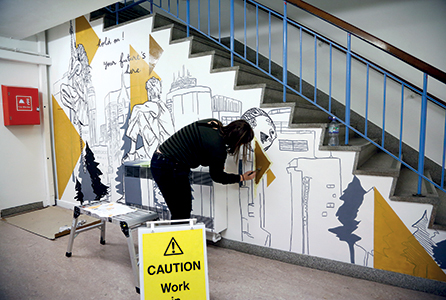
HNS Signs’ Michelle Henry at work on artwork for a busy corridor within Aston University
Social awareness
Interestingly, but not entirely surprisingly, social media is playing a significant role in the resurgence of traditional techniques, as both Smith and Osborne observe.
“Everything hand-made, and the older techniques, are making a come-back. Social media has influenced this, as more people get to see this kind of work and are attracted by it, including hand-painted murals,” Smith comments, adding: “As a result, even former graffiti artists have started learning the techniques; and I’m also seeing tattooists who want to learn the craft, including gilding and glasswork.”
Smith regularly features step-by-step videos on social media as well as film clips on YouTube. “Social media is the way forward, especially Instagram, and it’s leading to bigger jobs. Facebook is also having an effect to a great extent too. It spreads the word and promotes the business. Social media is brilliant,” asserts Smith.

Social media is the way forward, especially Instagram, and it’s leading to bigger jobs”
Osborne confirms the impact of social media: “As a result of social media and sites like Facebook and Instagram, the general public seem more aware than ever that traditional signwriters are back out there, brush in hand, and creating some unique and attention-grabbing sign-work in a way that modern sign-making practices can’t deliver. So now, rather than being told in the street while I’m working that ‘it’s a dying art’ (as was common a few years ago), members of the general public are pleased to comment on my work, and say that they saw signwriters on such-and-such, or in a magazine.”
Set fair for the future
So, does all this current interest bode well for the future of traditional techniques? Whitehurst sees the education of potential customers as being a key factor for a fair future: “I am not sure what lays in store for the future of traditional signwriting. But I think it relies on customers being made more aware of methods that can be used to enhance their business, making it different from the sterile use of vinyl graphics and printed signs.”
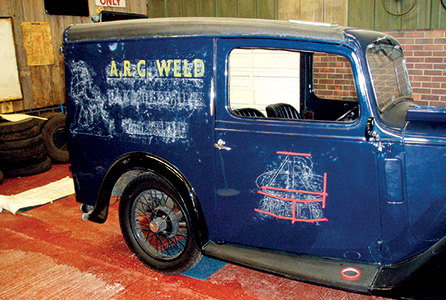
(Above & below) Three of the stages involved in hand painting livery to a 1930s Austin Ruby by SignCraft—chalked drawing in place, application of gold, and the finished work
Osborne concurs: “I would hope that with good signwriters out there, producing good work, it will continue to be recognised as a true craft and valuable method of sign production. There will always be work out there for skilled dedicated craftspeople who are prepared to go the extra mile and sell their work in the right way. Twenty years ago I was busy signwriting quite ordinary work, which could now easily and more economically be done in vinyl. This has left me free to explore more creative and lucrative markets, such as gold leaf work and high end pictorial work especially.”
Smith believes that the market will get stronger as this kind of work will always be valued: “It’s making a big come-back, but will never be back where it was in the 1960s and ‘70s. Glasswork is also coming back, as are all areas of traditional work—apart from vehicles, with the exception of vintage commercials and steam vehicles.”
He adds: “A combination of technology and traditional hand-work can work well in the right hands. It can take things to the next level and speeds up the process. For example, an image painted by hand can be produced digitally on special paper so that it can be transferred to glass, which saves the time it takes to do reverse work. However, personally, I like doing all the work by hand, including the actual cutting of a sign.”
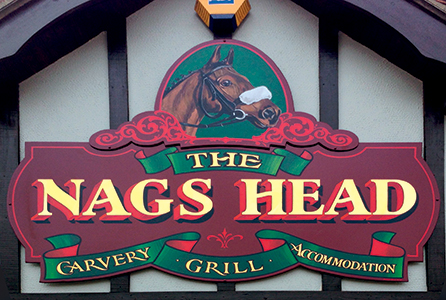
This handmade pictorial and lettered pub sign by Osborne Signs illustrates the traditional ‘feel’ that is now increasingly in demand from a wide range of sectors
Henry summarises: “I think that modern technologies have lessened the appeal of perfection. With our sales in this area having seen a 20 percent increase over the past twelve months, the old techniques have definitely become more fashionable and I think they will continue to do so.”
Spink endorses this view: “With neon signs and the art of creating them being in existence for more than 100 years now, we would say that there is definitely a bright future for neon sign making. Neon is also increasingly being used in other forms, rather than purely for signage. We are often asked for neon lighting, or a piece of neon art, but essentially the techniques and manufacturing processes are the same as for signage.”
Staying on course
With the demise of mainstream college training and the generally older average age of those currently skilled in traditional techniques, how are those skills being passed on to the younger generation to create the craftsmen (and women) for the future? Largely, it now lies in the hands of the current generation of craftsmen, many of whom run their own classes and courses.
“That’s the difficult bit,” says Dinsdale, adding: “I don’t think youngsters have the patience for it nowadays, as it takes two to three years to be really proficient. They like the idea but don’t want to spend the time, and this could be an issue. Many could do it and would be good but they will take some finding.”
Osborne has a different viewpoint: “I started running small classes in traditional signwriting and gilding around six or seven years ago. These are very popular and, such is the interest, there are now a lot of other signwriters who are offering something similar. A lot of young people are now coming up into the trade, and the value that access to social media groups online and contact with other signwriters provides to people wanting to ask advice and learn is incalculable.”
Osborne adds: “I recently took part in a crafts and building conservation careers day, and was overwhelmed with the response from students who just didn’t want to work on a computer all day.”
On the lack of formal college education, he notes: “I would love to see the return of something like the old City and Guilds qualification now in colleges, in its own right—and I think there would be a demand for it.”
Smith also runs his own workshops and ran at least one course a month during 2015. Indeed, people come over from the USA for his courses and Smith has also taught in Cincinnati and New Zealand.
Smith asserts: “It’s good to pass on the skills. The younger generation is becoming bored with the digital side as are customers, especially in London and towns like Totnes; they want something different from ‘cult digital’. They are interested in bringing paint back, especially gold leaf as it gives a ‘classier’ upmarket impression; they see this and appreciate it. The youngsters are out there and they want to learn.”
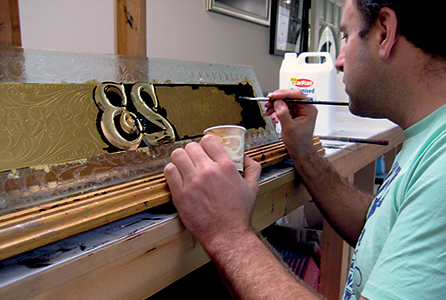
David Smith, shown here using gold leaf on reverse glass work, says that social media is helping to drive interest in traditional tech-niques and is leading to bigger jobs
Smith is a strong advocate of apprenticeships, saying: “Apprenticeships are coming back and this is a good move forward. I think strict apprenticeships are the best way to learn as they teach respect for both people and the processes.”
SignCraft’s Whitehurst gives a general overview: “To be classed as a skilled signwriter takes about five years of being constantly involved and immersed in the application of the trade. When I started in the trade 43 years ago you learned your trade from other skilled workers at long established sign workshops, watching
and adopting their methods and techniques.
“Companies who still have skilled tradesmen and women in their employment should try to encourage young people into the trade and set up trainee or apprenticeship courses. The skills involved in the true sense of the trade are hand-me-down skills and are not something that can be taught from a book or from someone with limited knowledge.
“The fact that colleges have dropped the initial starter courses and City & Guilds training that they used to offer has not helped; I think they and the government have missed an opportunity to keep these skills alive for future generations.”
With sign writing so deeply embedded in the company’s offering, HNS Signs has taken the in-house route, providing a very thorough and rounded training. “We train all of our staff to do traditional signwriting, even the graphic designers learn the basics. This is partly because we are passionate about it and partly because it helps the designers get a better understanding of what can be achieved prior to doing their designs.”
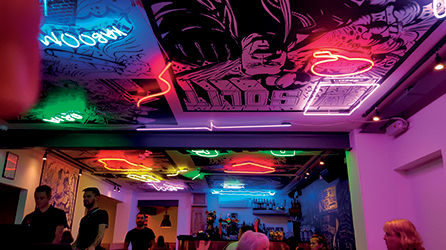
An array of ceiling neon forms the centrepiece of the Solita restaurant. Neon Creations collaborated with local artist Russell Meehan to develop a themed neon collection raining colour down onto diners
She continues: “We have invested a great deal of time into training apprentices by using our offices as their canvas. We will also get them to help us with any gold leaf or signwritten hon-ours boards. And we involve them in any onsite work so that they can get the confidence required to work alone. Sign painting on buildings in particular can be very tricky. To us, this is a very important skill. It is where the sign trade started and there is something very beautiful about the slight imperfections from a sign being made by paint onto a less than perfect surface.”
A similar situation pertains with regard to training in the skills and craft of neon making. Spink explains: “Because there is nowhere in the UK that you can physically go and learn to be a formal neon sign-maker, the responsibility lies with individual companies to actually train the next generation to do the job. We have, therefore, developed our own in-house training scheme in order to pass on this skill. Learning this art form is a great and unique opportunity for any young person, as it is a skill they will carry for life.”
The current demand for traditional techniques is clearly on a roll and there is great optimism for the future. However, to achieve this will require a degree of lateral thinking and looking at new and different ways in which these skills can be used, in order to keep them fresh in people’s minds. And it will be essential to pass them on to the younger generation in order to capture the surge in interest that is now emerging, whether through open courses, in-house training or apprenticeships.
It places a huge responsibility on the shoulders of those currently practising traditional techniques, but I believe their evident passion for their craft will ensure that there remains a very positive future for this sector.
Your text here...